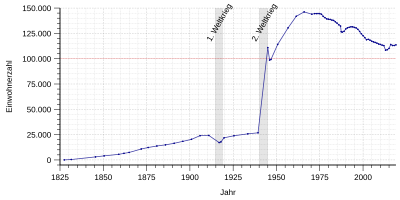Population development in Bremerhaven
This article shows the population development of Bremerhaven in tabular and graphic form.
Population development
In 1139 the church villages Geestendorf and Wulsdorf , located in what is now the city of Bremerhaven , and in 1275 the spots of Lehe north of the Geeste were first mentioned. For centuries, the places remained small villages with a few hundred inhabitants. Bremerhaven was founded on May 1, 1827, with 19 residents at the time. The city's population rose over 10,000 by 1871 and doubled to around 20,000 by 1900.
In the south of Bremerhaven, not far from the old Geestendorf settlement, a new settlement with 1,800 inhabitants was founded in 1845. The new system was named Geestemünde on June 26, 1847 . On April 1, 1889, the municipality of Geestendorf was incorporated into Geestemünde ("Hafenort Geestemünde" with around 15,000 inhabitants). Wulsdorf (4830 inhabitants) became a district of the city of Geestemünde on April 1, 1920.
On November 1, 1924, Lehe (38,105 inhabitants 1919) and Geestemünde (24,474 inhabitants 1919) merged to form the new city of Wesermünde with around 70,000 inhabitants. On November 1, 1939, Bremerhaven (26,790 inhabitants in 1939) and Wesermünde (86,041 inhabitants in 1939) merged to form the new city of Wesermünde with 113,000 inhabitants. On January 1, 1947, the city was renamed Bremerhaven . In 1968 the population reached its historic high of 148,931. Since then the population has been decreasing almost continuously. On December 31, 2009, the “ official number of inhabitants ” for Bremerhaven was 114,031 according to the state statistical office in Bremen (only main residences and after comparison with the other state offices).
The following overview shows the number of inhabitants according to the respective territorial status . Until 1833 it is mostly an estimate, then census results (¹) or official updates from the State Statistical Office. From 1871, the information relates to the “local population”, from 1925 to the resident population and since 1987 to the “population at the location of the main residence”. Before 1871, the number of inhabitants was determined according to inconsistent survey procedures.
Bremerhaven
Until 1970
(respective territorial status)
|
|
|
¹ census result
From 1971
(respective territorial status)
|
|
|
|
¹ census result
Source: Bremen State Statistical Office
Lehe
(respective territorial status)
|
|
¹ census result
² census result, in 510 residential buildings
³ census result, in 1043 residential buildings
Geestemünde
(respective territorial status)
|
|
¹ census result
Wesermünde
(respective territorial status)
|
|
¹ census result
Population forecast
The Bertelsmann Foundation , Guide to Demographic Change , provides data on the development of the population of 2,959 municipalities in Germany (published January 2006). For Bremerhaven, a population decline of 11.5% (13,660 people) between 2003 and 2020 was predicted.
The absolute population development relates to the years 2003 to 2020 and for Bremerhaven as main residences:
|
The forecast also has political and economic consequences because the municipal financial equalization depends on the number of inhabitants. In 2014, the city sued the Bremen Administrative Court because 5000 fewer residents had officially been expelled and the municipality of Bremerhaven received almost half a million euros less per year as a result.
Population structure
In Bremerhaven currently (as of June 30, 2012) 113,524 people live, of which 56,610 are male and 56,914 are female. 102,074 residents are German citizens and 11,450 foreigners. The percentage of foreigners is currently slightly over 10%.
literature
- Imperial Statistical Office (Ed.): Statistical Yearbook for the German Empire , 1880–1918.
- Statistisches Reichsamt (Ed.): Statistical yearbook for the German Reich , 1919–1941 / 42.
- German Association of Cities (Ed.): Statistical Yearbook of German Communities , 1890 ff.
- Federal Statistical Office (Ed.): Statistical Yearbook for the Federal Republic of Germany , 1952 ff.
Individual evidence
- ^ Björn Schwentker: Court judgment: Bremerhaven fails with census lawsuit. In: Spiegel Online . November 11, 2014, accessed June 10, 2018 .


